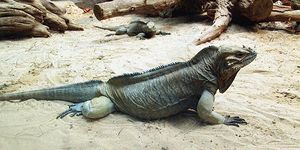Difference between revisions of "Rhinocerous Iguana"
| Line 26: | Line 26: | ||
These iguanas are ground dwelling lizards. In their native habitat these animals are seen on beaches, in grassy fields, and in barren open terrain that has some rocks/logs or similar cover. Juveniles may be largely arboreal. Adults will climb stout branches in search of food but climbing activity is usually restricted to finding a basking site on a large rock. | These iguanas are ground dwelling lizards. In their native habitat these animals are seen on beaches, in grassy fields, and in barren open terrain that has some rocks/logs or similar cover. Juveniles may be largely arboreal. Adults will climb stout branches in search of food but climbing activity is usually restricted to finding a basking site on a large rock. | ||
| − | Cyclura do not usually live very long in captivity (usually less then 8 years, far shorter then probable natural life spans). Successful captive management will depend largely on enclosure design. Sufficient space is essential; a single pair of adult rhino iguanas should have a minimum of approximately 9m2 of well-designed enclosure floor space. A large outdoor summer enclosure should be considered as can be seen at London Zoo. Basking sites need to be available to all inhabitants. | + | ''Cyclura'' species do not usually live very long in captivity (usually less then 8 years, far shorter then probable natural life spans). Successful captive management will depend largely on enclosure design. Sufficient space is essential; a single pair of adult rhino iguanas should have a minimum of approximately 9m2 of well-designed enclosure floor space. A large outdoor summer enclosure should be considered as can be seen at London Zoo. Basking sites need to be available to all inhabitants. |
Retreats or some form of cavity or burrow to allow complete concealment of the iguanas will reduce nervousness and the likelihood of fighting. Ideally, visual barriers (rocks piled into walls) should be arranged to ensure that feeding, basking and shade areas are individually available to potentially incompatible iguanas. | Retreats or some form of cavity or burrow to allow complete concealment of the iguanas will reduce nervousness and the likelihood of fighting. Ideally, visual barriers (rocks piled into walls) should be arranged to ensure that feeding, basking and shade areas are individually available to potentially incompatible iguanas. | ||
Revision as of 14:26, 2 April 2010
| This article has been peer reviewed but is awaiting expert review. If you would like to help with this, please see more information about expert reviewing. |
Scientific name: Cyclura nubila caymenensis
Other names: Cayman Island ground iguanas

Description
The members of the rhinoceros iguana group are similar in size, morphology and behaviour. They are stout bulldog-like animals. The teeth are solid and broad, and the jaw muscles are extremely powerful. The neck is short and muscular. Any bite from these animals should be considered dangerous. The tail is compressed and well muscled and can deliver a solid whipping blow. Like many other giant species their coloration is dark olive-green to brown. They may appear slow and clumsy but can move for short distances with great speed lifting the body high off the ground.
The young are about 18cm long at hatching and are active lizards. Maturity is reached in 5-7 years.
Range
Rhinoceros iguanas are restricted to the Caribbean islands, where each taxon occupies a restricted and usually exclusive distribution within the area.
In all cases, habitat destruction by man and the introduction of animals such as pigs and goats has pushed these iguanas to the point of near extinction. They are listed as endangered by CITES and individual Caribbean governments.
Diet
Rhino iguanas are basically herbivorous, eating foliage, leaves and greens, fruits and flowers, vegetables, root crops and squash, legumes and eggs, but they will also eat small mammals and invertebrates. In captivity they require large, varied, frequent and nutritionally balanced feedings.
Enclosure
These iguanas are ground dwelling lizards. In their native habitat these animals are seen on beaches, in grassy fields, and in barren open terrain that has some rocks/logs or similar cover. Juveniles may be largely arboreal. Adults will climb stout branches in search of food but climbing activity is usually restricted to finding a basking site on a large rock.
Cyclura species do not usually live very long in captivity (usually less then 8 years, far shorter then probable natural life spans). Successful captive management will depend largely on enclosure design. Sufficient space is essential; a single pair of adult rhino iguanas should have a minimum of approximately 9m2 of well-designed enclosure floor space. A large outdoor summer enclosure should be considered as can be seen at London Zoo. Basking sites need to be available to all inhabitants.
Retreats or some form of cavity or burrow to allow complete concealment of the iguanas will reduce nervousness and the likelihood of fighting. Ideally, visual barriers (rocks piled into walls) should be arranged to ensure that feeding, basking and shade areas are individually available to potentially incompatible iguanas.
A single pair will be the most compatible group. A group of more than this will establish a dominance hierarchy. This is most obvious in the males and dominance appears always to be size related.
Temperature
The temperature gradient during the day should range from 27ºC on the cool side to 34ºC on the warm side. The basking areas should range from 36-40ºC. The night-time temperature should not drop below 23ºC.